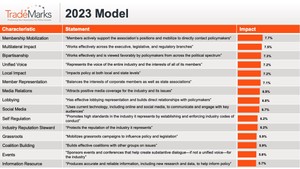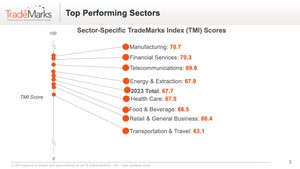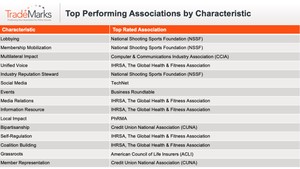
Learn about the factors that determine trade association effectiveness in the United States
What is TradeMarks?
TradeMarks is a research study which helps trade associations measure the extent to which policy leaders believe they are effective in achieving their policy goals. Grounded in more than 30 years of experience studying the attitudes and perception of policy leaders, APCO produced the first-ever study to tackle the question of association public policy effectiveness with a systematic, survey-based and objective approach. Policy makers and influencers rate associations on both overall effectiveness and a range of detailed areas. The results show in detail where associations must excel in order to enhance their impact.
With the release of our ninth study in the series, we continue to discern patterns in the data, identify shifts in policy leader expectations and provide associations with a data-driven roadmap for engagement strategies that enhance impact. Read the 2023 press release.
Model
APCO Insight® developed the TradeMarks Study to identify the key characteristics that define association effectiveness in achieving the public policy priorities of its members. Advanced statistical analysis allowed us to isolate the characteristics that have the most impact in shaping policy success, helping associations to act with conviction. This same model has been used in subsequent studies.
Think all characteristics are equal? Think again.
The 2023 model reveals challenges and opportunities facing associations:
- Association effectiveness is relatively stable, softening only slightly since 2022. Despite the decline after the COVID-19 bump, overall performance remains higher than all years surveyed prior to 2021.
- Interest in meeting with association members escalates after the full reopening of Congress. Membership Mobilization, Member Representation and Unified Voice all rise in prominence in 2023 indicating the growing impact of communicating association and member interests.
- Buoyed by a split DC and new issues being sent back to the states, Local Impact grows in impact. Policy Elites’ focus on a higher level of state and local activity places a growing impact on and performance expectation of Local Impact to be considered an effective policy advocate.
- Renewed emphasis on stakeholder identification and relationship development. Multilateral Impact and Bipartisanship continue to be essential for associations to be considered effective advocates. While relatively lower in importance, Lobbying remains a core association asset.
Top Rated Sectors
For the first time in our survey, Manufacturing is collectively the most effective sector, with a TMI of 70.7. It is likely that the Bipartisan Infrastructure Law, a growing emphasis on domestic production and increased efforts to combat supply chain issues are boosting effectiveness perspectives. The Financial Services and the Technology sectors each maintain their 2nd and 3rd positions, exhibiting stability and resilience over the past few years. While Health Care has consistently held the 1st or 2nd highest position, the sector is ranked 5th in 2023 as TMI decreases by approximately 3 points – a possible reflection of continued high costs, HCP recruitment & retention issues and dissonance within the industry. Transportation & Travel, Retail/General Business and Food & Beverage appear to be facing prolonged challenges since the pandemic.
The gap between sectors on perceived performance has widened–a difference of 7.6 points separates the top and bottom rated sectors–with three sectors distinguishing themselves this year while one lags significantly. In 2022 only a 4.5-point separation was present, in 2021 a 5.1-point gap and in 2019 there was a 4.9-point spread.
Top Rated Associations
Policy leaders recognize that different associations focus their public policy efforts in different areas. By understanding how the associations are viewed on each of the discrete drivers of effectiveness (characteristics) and the relative impact these drivers have in shaping overall effectiveness, the TradeMarks Model prioritizes the most important strengths to be leveraged and the most important opportunities to be seized to increase effectiveness.
The table displayed shows which association has the highest performance rating on each of the 15 characteristics that comprise the TradeMarks Model. In 2023, eight different associations are viewed as performing best across the 15 characteristics.
About
About the TradeMarks Model
TradeMarks is a groundbreaking model developed by APCO Insight that measures the extent to which policy leaders believe associations are effective in achieving their policy goals for their members.
TradeMarks is the first study to ever tackle the question of association effectiveness with a formal, systematic and objective approach. The TradeMarks model pinpoints the specific actions that can be taken to achieve optimal impact in each area and quantitatively determines the relative impact of each factor. It allows associations not only to gauge their effectiveness, but also to provide an actionable roadmap for how to increase their perceived effectiveness and achieve their desired outcomes.
By understanding how the associations are viewed on each of the discrete drivers of effectiveness (characteristics) and the relative impact these drivers have in shaping overall effectiveness, the TradeMarks model prioritizes the most important strengths to be leveraged and the most important opportunities to be seized to increase effectiveness.
The TradeMarks Model: Methodology
The TradeMarks Model is informed by more than 30 years of conducting qualitative and quantitative research for associations among Washington, D.C., policy leaders—the Members of Congress and their staff, executive branch professionals and other influencers who shape the opinions of associations.
Based on this experience and conversations with our partners, a list of 52 characteristics that define association effectiveness on policy issues was developed. A pre-test survey was conducted among policy leaders to isolate and validate the key characteristics that drive perceptions of association policy effectiveness; the modeling identified 15 valid factors that explain what policy leaders consider when evaluating an association’s public policy effectiveness.
In 2013, a full-scale survey of policy leaders in Washington, D.C., was conducted using a mixed-mode methodology offering respondents the opportunity to complete the survey either online or over the telephone.
Policy leaders were asked to evaluate five randomly-selected associations with whom they are familiar from a list of 50 associations in Washington, D.C. The results shown on this site are limited to data for the overall association sector represented by the 50 associations. All data, including association-level data, are the exclusive property of APCO Worldwide. For information on findings for individual associations, please click here to contact us for more information.
Beginning in 2014, this study was repeated annually using the same methodology.
About the Rankings
The Rankings present the top scoring organization for each characteristic, from among the trade associations we studied in Washington, D.C., using the TradeMarks methodology. As such, rankings do not necessarily include “best in D.C.” — some organizations were not reviewed. Furthermore, top scores on a particular characteristic should not be interpreted as receiving top scores overall. Some organizations performing very high in aggregate on the TradeMarks Index did not receive top marks in any one category.



